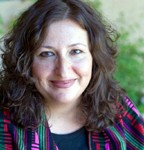Monica Brown’s mother always told her she was a “citizen of the world.” Born in Mountain View, California, Brown is the daughter of a Peruvian mother and a father of mixed Scottish-European descent. Many of Brown’s childhood memories center around her mother. “She was a really amazing woman that I was really close to,” she says. “She was a fun, creative woman. She was an artist. And a storyteller, too. I loved hearing stories about her childhood.”
Brown’s love of Latin American culture guided her career path. Originally a journalist in Guadalajara, Mexico, she is now a tenured professor of English specializing in Latino and multicultural literature at Northern Arizona University in Flagstaff. The author of several scholarly books and articles in her field, she branched out to children’s literature as a cultural consultant for a new bilingual publishing imprint as a favor to a former student-turned-editor. “It was the perfect storm,” Brown says. “My children were picture book age and it seemed a natural evolution of my writing career.” Her books cover a wide variety of Latin American heroes: poet Pablo Neruda; activists Dolores Huerta and Cesar Chavez; singer Celia Cruz; and soccer star Pelé. Brown’s stories are for her children who are one step removed from their Peruvian roots.
The key to a successful picture book is the perfect blending of art and text. “As the daughter of an artist, I knew I was good at writing for artists,” Brown says. “I could imagine the illustrations and the play of words. You need illustratable action and movement on each page and that can be challenging when you’re writing about a writer. It sounds basic, but it’s an important concept for this genre.” Brown’s favorite part of creating books for children is the day the art arrives in her mailbox. “I get a deep sense of satisfaction that these beautiful paintings exist because of my story.”
In her award-winning picture book biographies, Brown focuses on a single aspect of her subjects’ lives. For instance, in an upcoming biography of Pablo Picasso, she uncovered two tiny details in her research. According to family legend, Picasso’s first words werepiz piz—short for lápiz (pencil). Picasso also had difficulty with numbers. A six looked like a bird’s wing and a seven looked like an upside down nose. Brown decided to focus on those details because they captured the essence of what made him an artist.
In spite of her hectic schedule, Brown prefers to conduct her own research rather than hire an assistant. “I’m trained as a scholar and I’m good at research,” she says. “ForPablo Neruda: Poet of the People, I reread his poems and one or two biographies.” When she crafted the text of the story, she included a dream sequence to create space for her imagination. “A lot of my biographies have dream sequences,” she says.
Waiting for Biblioburro was inspired by Luis Soriano who carted books by burro to isolated Columbian villages. Brown’s story received the 2012 Christopher Award in the Books for Young People category because it “affirms the highest values of the human spirit.” Brown says, “The Christopher medallion quotes a Chinese proverb, ‘It is better to light one candle than to curse the darkness.’ I love that because that’s what Luis did.”
Marisol, the title character of Marisol McDonald Doesn’t Match, is Brown’s most autobiographical character because Marisol is biracial too. When writing the book, Brown drew on cultural clashes and unusual questions from family and friends as the child of a South American mother and a North American father. “Marisol represents the millions of children that can check more than one box,” Brown says, although she admits it was the hardest story to publish and received more rejections than any of her other manuscripts. Regardless, Marisol continues to be one of Brown’s favorite characters because “she is the affirmation of the experiences of millions of families in the United States.”
Brown laughs when asked about her daily writing schedule. “Teaching is exhausting,” she says of her job as a full-time professor. “You have to be creative to teach well.” Throw in a busy family life with two teenage daughters and her husband (a professor of Native American literature), and Brown is often desperate to find the time to write. She carves out some time on Fridays—her only non-class day, weekends, and summer. During her last sabbatical, she wrote three or four books. One trick she uses is to work on more than one manuscript at once. That way if she becomes frustrated or needs a break, she moves to another project.
As a scholar, Brown has run into some resistance to her work in children’s literature. Many people believe picture books are a lesser art form and therefore easier. But Brown disagrees. “Children’s imaginations are so open,” she says. “Children’s books play an essential part in their literacy acquisition and their language and communication skills.”


